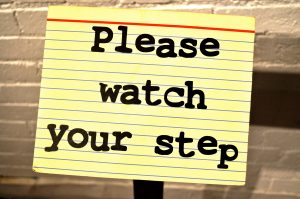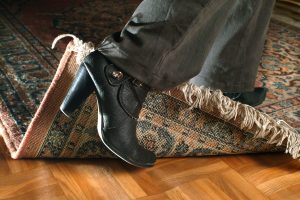 “Ever since she fell it’s been downhill from there…”
“Ever since she fell it’s been downhill from there…”
We’ve heard this so many times!
According to the Centers for Disease Control (CDC), of people 65 and over, more than one out of four of them fall. This equates to about 3 million people treated in emergency rooms and over 800,000 patients hospitalized annually due to complications from a fall.
While the majority of falls do not cause significant physical problems, approximately 20% of falls do cause serious injuries such as broken bones, head trauma, or simply increase both the fear and the likelihood of future falls.
Common Causes of Falls
Falls are caused by a variety or combination of risk factors and experiences. The greater the number of risk factors, the more increased the fall risk becomes. The American Geriatrics Society’s Health in Aging Foundation summarizes the most common risk factors as:
1. Physical/Health Risks: This includes health conditions or illnesses that can affect balance and gait – many of which can develop as we age. Some examples of these conditions include:
- diseases such as diabetes (low blood sugar), arthritis, Parkinson’s disease, heart disease, blood disorders, Alzheimer’s disease or dementia
- chronic conditions related to the thyroid or feet, sensory issues (reduced vision or hearing), pain, muscle weakness or numbness (neuropathy), balance issues or depression
- dehydration or urinary incontinence
- slower reflexes
- inability to adapt to walking in the dark and reduced depth perception
2. Lifestyle or Behavior Risks: Even if you consider yourself to be in good health overall, fall risks can still be exacerbated by certain medications and by lower levels of physical activity.
Many medications, whether they be prescription or over-the-counter, may affect your balance, coordination or hydration, or can interact in potentially harmful ways with other medications. Certain pain medications, antidepressants, psychiatric medication, blood pressure medication, insulin, or sedatives are examples of medications that can potentially increase a fall risk due to side effects like dizziness or confusion. Moreover, as we age, medications typically take longer to break down and will stay in the body longer.
Lack of exercise can also be a cause of an increased fall risk. Specifically, leading a sedentary lifestyle with reduced sun exposure could lead to a vitamin D deficiency. (Vitamin D is needed to keep bones strong.) Additionally, common ailments like arthritis or chronic pain can put a halt to a regular exercise routine and lead to less overall physical activity, which can lead to weaker muscles.
3. Environmental Risks: Tripping and fall risks can be increased by environmental factors such as:
- Inside home hazards like throw rugs or loose carpets, clutter, poor lighting in hallways, stairs, and rooms, or slippery floors
- Outside home hazards like uneven pavement, yard clutter, or ice and snow
- Poor or unsuitable footwear like shoes with heels or slippery bottoms
- Improper usage of walking aides
- Sudden occasional events like a dog pulling a leash or going after a running child
Fall Prevention
There are a number of proactive steps that you can take to help prevent falls. The National Institute on Aging and the Mayo Clinic offer the following recommendations:
- Communication with your doctor. You should keep regular appointments with your doctor and discuss the medications that you are taking and current health conditions that may cause a fall. And, always tell your doctor about any falls you have had (even if you were unhurt) and the conditions surrounding it since your last visit. This can help your doctor with strategies tailored to you that can help fall prevention in the future.
- Stay active. Regular doctor-approved activities like walking, swimming, or a light exercise regimen can make your muscles and joints stronger and improve strength, flexibility, and coordination and may even slow bone loss.
- Safeguard your home: To make your home safer from accidental falls, consider:
- removing excess clutter
- repairing any loose rugs or flooring
- keeping electrical cords or other trip hazards away from walkways
- drying up any areas that have gotten wet through spills or tracking in rain/snow
- using non-slip mats in the bathtub
- keeping often-used items within reach (so you don’t have to climb on a ladder or use a step-stool)
- sanding or salting slippery outdoor areas
- keeping your home brightly lit with lamps, night lights, light switches and flashlights that are easily assessable.
- Sensible self-care: Keep up-to-date with blood pressure checks and vision and hearing tests. And, if you need them, use assistive devises such as glasses/contact lenses, hearing aids, hand rails, grab bars in the bathroom, non-slip floor or step coverings, canes, or walkers. Also, make sure to get enough sleep, limit alcohol consumption, and of course, wear properly-fitting and sensible shoes!
Falls or fear of falling can negatively impact a person’s quality of life or seriously impact their health and mental wellness.
The key is to prevent falls before they happen or reduce the chance of a bad accident by recognizing the reasons why someone might trip or fall.
By taking simple precautions, having a good understanding of health conditions and medications, and making subtle lifestyle changes, we can help our loved ones (and ourselves!) avert a scary and possibly, life-altering injury from a fall.
Related Posts:
Key Tips for Living With Hearing Loss
Careful Home Design Makes Aging in Place Possible
What to Do When Your Parent is a Hoarder
Downsizing: 6 Easy Steps to Success
Positive Aging: Why It Matters and Where to Start
 Connecticut Estate Planning Attorneys Blog
Connecticut Estate Planning Attorneys Blog


